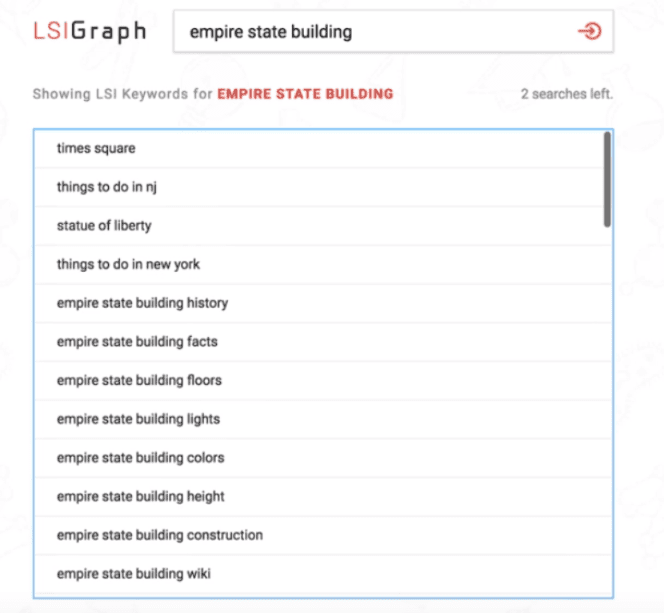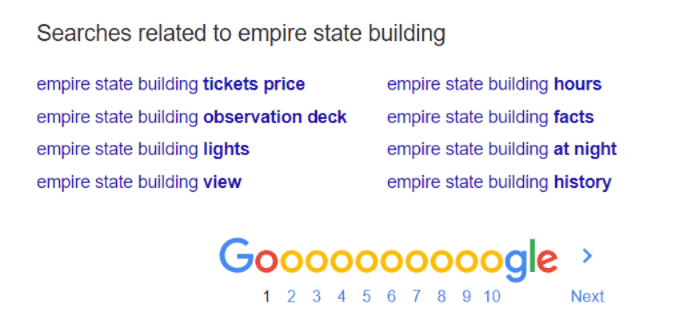Learn EXACTLY how to use latent semantic indexing or LSI keywords as part of your on-page SEO strategy to get higher rankings and more organic traffic.
Today you’re going to learn about Latent Semantic Indexing (or LSI).
This is a phenomenal content marketing SEO strategy that you should be using in all of your SEO copy to increase search volume.
If you have any URLs out on your website that you want to rank higher in search engines, and they’re not quite there, you absolutely should be applying Latent Semantic Indexing principles to your copy.
We’re going to talk about exactly what Latent Semantic Indexing SEO is, how LSI works, the fastest way to implement it on your web pages, and how to get that going right away.
What is LSI?
Latent Semantic Indexing (LSI) is just a fancy way to say “additional relevant keywords”.
The term is relatively new to the SEO world, but not as new in the academic world. Latent Semantic Indexing and Latent Semantic Analysis have been around since the late 1980s, dealing with natural language processing and distributional semantics. What they did back then was create a matrix out of a large text and use a mathematical technique (singular value decomposition) to analyze the relationships between two documents and the related terms they contain. In 1988, Susan Dumais, George Furnas, Thomas Landauer, Karen Lochbaum, Richard Harshman, Lynn Streeter, and Scott Deerwester patented an information retrieval technique using this research tool.
The same basic principles apply in Latent Semantic Indexing or Latent Semantic Analysis SEO as well. Search engines use an information retrieval technique to analyze the terms in documents, and this helps them populate SERPs with the best options for users.
Google’s algorithm has a very difficult job in trying to rank documents. When a searcher searches in Google search, Google has to find the 10 most relevant documents to show on the first page of results for the given search terms, and LSI is just a way to help them do that.
LSI is a super-important part of copywriting these days, specifically copywriting that’s beneficial for search engines.
The basic idea here is that several long-tail keywords do not necessarily fall into the synonym category but are incredibly contextually relevant to your primary keyword.
Before we dive into the topic of semantic keywords, just a quick reminder: this is a component of Search Engine Optimization (SEO), and SEO is only one piece of digital marketing.
We’re going to be diving specifically into one SEO topic today (as mentioned above, LSI). But as a marketer, you should keep in mind that your entire digital marketing strategy should be composed of much more than just Search Engine Optimization.
SEO Copywriting Basics
It’s important to understand the basics a little bit before we dive more into LSI and what it is.
So, let’s say I have a website and I’m trying to rank a page on that website for a target keyword.
What are the things that I need to do to get that page ranking?
From an on-page SEO perspective, the very basic thing to do is use the primary keyword exactly as it’s written about two or three times in your piece of content.
Google understands synonyms related to that main keyword, so go ahead and sprinkle a couple of those in the copy where it’s reasonable.
Remember, you’re writing this for humans, not search engines.
I made this massive mistake when I first got into Search Engine Optimization: I would design my copy for search engines, not for readers, and overload my content with a massive number of keywords (aka keyword stuffing). That means I wrote a very, very spammy, gross-sounding copy.
It sucked—so don’t do that. Make sure that you’re writing your copy for humans.
What I like to do is write my copy first and then go back right before I hit publish and do all of my SEO tweaks (getting my primary keyword in there two or three times, getting some related words based on semantic search there a couple of times, reading it all out loud before I publish).
I generally find much better results in doing it that way. If it sounds terrible when you read it out loud, you’re doing it wrong—so re-work it until it sounds great.
How to use LSI keywords for SEO copywriting?
Once you’ve done your core copy, you’ve added your primary keyword and some synonyms in there, you will want to look at LSI keywords research.
LSI is just a fancy way to say “other contextually relevant keywords”. It’s consisted of words that are thematically related to your core keyword.
For example, if my core keyword was “Empire State Building”, some other synonyms for “building” might be “tower”, “skyscraper”, or “high-rise”.
Latent Semantic Indexing keywords would be words that are thematically related, but not synonyms.
In the “Empire State Building” case, the relevant keyword suggestions would be keywords like “New York City”, “Guinness Book of World Records”, “sightseeing”, and so on.
The list of LSI keywords is not related to a building at all, but in all these other pages that are out on the web that are mentioning the Empire State Building, “New York City”, “Guinness Book of World Records”, and “sightseeing” are consistently coming up.
There’s a thematic relationship between these phrases.
The idea here is you can signal that document relevance for related searches to any search engine crawling your documents if you have a lot of these LSI keywords in there.
How to find LSI keywords?
There are a couple of different ways to figure out what your LSI keywords are.
My first and favorite way is LSIGraph.com. You plug your primary keyword in and it will render a bunch of results for you that show you Latent-Semantic-Indexing-related keywords.
To use this keyword tool, go to LSIGraph.com, input your primary keyword in the search box, and then click “Generate”.
In my example below, I entered “Empire State Building” and the LSI Graph tool gave me all these keywords it thinks that are related:

These are not synonyms for “building”, but the entire universe of possible documents that might contain the words “Empire State Building”.
The basic idea here is that LSI keywords are useful from a document relevance perspective. I want to add as many of these to my document as possible.
Keep in mind: the same keyword-usage rules apply here as well. Make sure to read your copy out loud. Don’t include anything that’s not great for users.
You want to signal that document relevance, so if you can, add as many LSI keywords into your document as possible—but keep it user-friendly at all times.
Another great tactic people frequently overlook is Google: Just Google your keyword.
Once you’re on the results page, scroll down to the bottom and go to the “Searches related to…” (in my case, this was “Searches related to Empire State Building).

Google gives you these answers. It thinks those queries are related to your initial query.
For example, I Googled “Empire State Building” and I got “Empire State Building ticket prices”, facts, floors, history, and hours.
This particular search query might not be a great example for LSI because there are a lot of navigational queries here. But sometimes, just Googling the keyword works very well as an LSI keyword generator.
That’s it. That is Latent Semantic Indexing or LSI—keywords that are not necessarily synonymous to your primary keyword, but rather contextually related to it. This page SEO content strategy will help search engines better determine what your content is about (thus, pushing you higher in the SERPs).